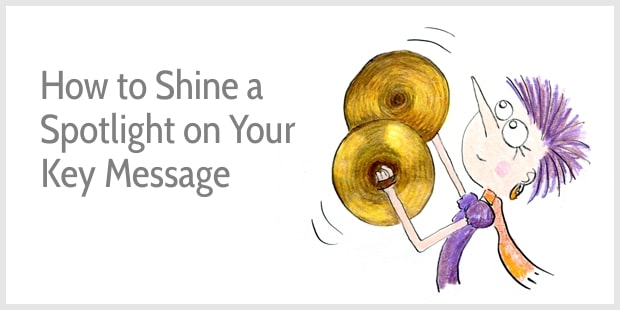 Imagine a text that sounds as good as your favorite song …
Imagine a text that sounds as good as your favorite song …
Reading would be a pleasure, right?
And the key message might linger in your mind—just like the chorus of that song.
Can it be done?
Writing has rhythm, too
Rhythm is one of the most underappreciated aspects of writing.
Yet, a good rhythm not only makes the reading experience more pleasurable; it can help put a spotlight on your key points, too.
This works for any type of writing, whether you’re writing a novel or a memoir, a sales page or an email.
And the key to creating such a pleasant rhythm?
Vary the length of your sentences.
I’ve always found this aspect of writing hard to explain. That’s until I spotted a perfect example …
How to vary sentence length
The Kitchen Congregation is a lovely food memoir written by Nora Seton (thank you to reader Paul Couchman for the recommendation).
Here’s how Seton describes her mother:
She was a good cook. People remember that about her. Oh yes, yes, she wrote several novels, received critical acclaim, battled cancer, raised five children. But she was a good cook. She was a good cook not because the feeding of a family of seven, plus routine entertaining, and the importation of odd sojourners into our house for months at a time beat the basics into her. She thought about it. She cared.
Why is it so good?
First, because the rhythm of the writing is pleasant. Have you tried reading it aloud?
When you read the paragraph aloud, you may notice that the long sentences speed up the reading; it’s like you’re accelerating towards the next full stop. In contrast, the short sentences slow you down a little. Because each full stop makes you pause.
If you think of it as a road journey, the long sentences are the stretches of highway where you can step on the pedal, make good progress, and only occasionally have to slow down before you can overtake a truck.
Short sentences are more like city driving. First, red traffic lights make you stop. Then a couple of kids are crossing the road. So, you have to stop again. You know how it goes.
Good writing has a mix of smooth highway driving and stop-start city driving. This variation in driving experience keeps readers interested.
But there’s more …
Nora Seton’s paragraph showcases perfectly Roy Peter Clark’s advice:
Long sentences take readers on a journey. Short ones tell the gospel truth.
Shall we see how that works?
The two long sentences in Seton’s paragraph take you on a journey:
Do you notice how each of these two sentences tells a story? That’s why they take you on a journey.
And the short sentences put the spotlight on the gospel truth:
The short sentences state the truth, without meandering into a story. These sentences simply tell you: This is how it was.
Note how the second short sentence—But she was a good cook—repeats the first. This repetition gives extra stress to the key message: She’s a good cook!
Rhythm is not just for creative writers. Any type of writing has a rhythm. Even sales copy …
The rhythm of Apple’s copy
Apple’s copywriters understand the power of rhythm, too.
On the sales pages of the iPhone 13 Pro, they explain how they developed the Neural Engine so you can make Hollywood-like movies with your iPhone:
We also trained the Neural Engine to work like the experts. It makes on-the-fly decisions about what should be in focus, and it applies smooth focus transitions when that changes. If you want creative control, you can always hop in the director’s chair and rack focus manually, either when you shoot or in the edit.
It’s so computationally intense, we needed a chip that could handle the workload. Enter A15 Bionic.
The sheer computational power needed to run the machine learning algorithms, render autofocus changes, support manual focus changes and grade each frame in Dolby Vision — all in real time — is astounding.
It’s like having Hollywood in your pocket.
The rhythm is perhaps not as smooth as Seton’s writing but the long sentences follow the same principle of taking readers on a journey:
Each long sentence communicates a lot of information helping you picture what it’s like shooting a movie with your iPhone. Can you imagine hopping in the director’s chair?
The key points are communicated in the shorter sentences:
The two short-ish sentences summarize what’s most important:
That message is even easier to remember because of the strong imagery of Hollywood in your pocket.
3 guidelines for varying sentence length
Just like in music, there’s not just one pattern of sentence length that’s best. You can jig or jive, you can sprint or saunter, you can rap or rock.
Yet, there are 3 useful guidelines to remember while playing with rhythm:
- Reading becomes monotonous when all sentences are similar in length. To create a pleasant reading experience, vary the length of your sentences.
- Short sentences make readers pause. So, use short sentences to shine a spotlight on your key points.
- Long sentences take readers on a journey and speed up the reading experience.
Below follows a visual representation of the rhythm of Seton’s paragraph. The short sentences are highlighted in orange; the long sentences are grey; the medium sentence is without highlight:
She was a good cook. People remember that about her. Oh yes, yes, she wrote several novels, received critical acclaim, battled cancer, raised five children. But she was a good cook. She was a good cook not because the feeding of a family of seven, plus routine entertaining, and the importation of odd sojourners into our house for months at a time beat the basics into her. She thought about it. She cared.
How to put music into your writing
The best way to develop a sense for rhythm is to read good writing aloud and pay attention to the variation in sentence length.
Next, start playing with your own writing.
Try writing a couple of longer sentences. Or chop a longer sentence up into shorter ones.
Then evaluate: How does the rhythm change? Is the spotlight on a key point?
The rhythm of your sentences helps shape your voice.
So, don’t worry about creating a perfect rhythm.
Just play.
Happy writing!
Recommended reading on rhythm and varying sentence length:
How to write a dazzling long sentence
Word repetition: How to make your writing resonate
How the rule of three puts music into your writing


This is great. I haven’t come across explanations like this since I have started my research on writing. Today, I needed a detailed explanation on the use of rhythm, and here I come. My goodness! It’s beyond my expectations and I felt like giving a warm hug to the writer while reading through.
Thank you so much for putting this out here.
I will be using it to explain how public speakers can strategically win their audience’s attention.
Love you!
Thanks so much, Jumoke. I’m glad you found this useful. Your hug is appreciated!
Hi,
thank you very much. I’m learning english and I learn reading with you.
It’s a very pleasure to read your writing.
It’s always clear and imaged.
I’m a piano teacher and the rythm speaks to me.
Thank you so much!
Aww, what a lovely compliment. Thank you, Alexandra!
Hi Henneke,
It was an amazing share! I have been trying to write as well, and I am progressing, but I struggle with engagement. Your tips about varying sentence structure to highlight key messages will be very valuable for me. I think it will boost the rhythm of writing. I think I will try reading them out loud to gain a better understanding of the structure and modify it accordingly. Thanks a lot for sharing your tips, it was very helpful.
I’m glad you found it helpful, John. Happy writing!
I definitely understand what you mean by the rhythm of writing Henneke. When in the flow the tempo carries me through my work. I need to write slowly but quickly enough to find the right sentence length from sentence to sentence. This feels tough to put into words but you did a great job explaining the concept within this post.
Ryan
Yes, when you’re in a flow, there’s often a natural rhythm. Still, I often fine-tune the rhythm when editing.
Henneke your blogs are always so informative I just love them.
Thank you, Jake 🙂
Brilliant, as usual, young lady!
XOXOXO
Thanks so much, Jim. How lovely to be called a young lady! 🙂
Such a gem.
Seton’s rhythm is exceptional, but how you work that same rhythm into your explanation makes it all that clear to understand and appreciate.
A perfect gem.
Thank you for your lovely compliment, Michael. It was fun to write this post. 🙂
By the way, Happy New Year Mam Henneke.
A piece of golden advice, one that would create wonders about my own brand of writing.
For years, I have been struggling with how to write content that really matters. Fortunately for me, you have been there to provide exceptional and truly practical advice-priceless gems; the way I see. So again, thank you and more power.
Happy New Year to you, too, Daniel. I’m glad you’re finding the tips on my blog useful. Happy writing!
Henneke, you did it well. You held me through till the end and I saw you practicing what you were demonstrating in this post. Yes, you varied your sentences. Good.
Thank you, Enock. I’m glad you enjoyed this all the way to the end 🙂
Sometimes feeling tortured.
Because I love your blog posts.
And I can’t wait to devour them.
But finding myself twitching like an addict every other Monday night.
Waiting for a Tuesday morning inspirational and educational fix.
Sorry. Not sorry for the irritating way I started some of these sentences.
Thanks, and stay safe.
Awww, Phil. You’re making me blush 😊
I don’t know what I can do to relieve the pain of addiction but I’ll do my best to keep writing and be here every other week.
Thank you so much for your kind words. Take care and be safe.
I feel like a spoken-word artist when I read Seton’s piece😊
Thank you for this informative blog post. 😊😊
You were an artist 🙂 Amazing writing by Seton, eh?
Yikes! Thanks for the correction.
Still polishing 😊
It wasn’t a correction. I was just suggesting that if you felt like an artist, you probably were an artist. Happy writing and happy reading!
My bad. Got you now. 😊 Thanks
Love this, Henneke! I’m here in the states reading the paragraph out loud at my desk 😊 The words do just flow. It’s rhythmic, like you said. Conversational. Thanks for the article and for all that you do!
It’s lovely when writing flows like this, isn’t it? I’m glad you enjoyed it, too. Thank you for stopping by, Kristen!
I loved your example. It feels exactly as you describe it and it grabs one’s attention.
Thank you, Ana. I am glad you like it, too. I have now read it at least 10 times and I still like it 🙂
Whenever I read your blog, I feel a sense of positivity, love and compassion.
Thank you so much for creating this blog. 🥰
Awww, thank you so much, Rajneesh. That’s a lovely compliment.
I love such rhythm in writing and try to use it as much as possible.
I also love using parallel construction, alliteration, and rhyme for parallel ideas.
“Dreading detractors? Fearing foes? Intimidated by your in-laws? All those reasons to be reluctant even to write, right?”
Like that.
So are the styles mutually exclusive? And when we’ve worked hard to make short sentences bounce off the backboard of a long sentence, can it be too forced or even appear artificial or overdone? I never want to get so carried away that folks lose the depth of a story because they are loving what the author did—analyzing the technique, etc.
Yes, parallel construction, any type of rhyme (incl. alliteration), and repetition all contribute to rhythm and you can use them all.
It can be overdone but there’s no objective rule. For instance, some people think Nora Ephron uses repetition too much. But I like how she uses repetition—it makes her voice strong.
I would recommend leaving a draft for at least 24 hours, and then reading it aloud. You probably already do that! If you’re honest with yourself, you’ll know whether you like it or whether you’ve been pushing a little too far, whether you’re trying to show off a little too much.
Yes! Like when I consult a thesaurus to find one more…???
I have no problem with consulting a thesaurus. I do it, too, sometimes 🙂
What a beautiful conflagration of words AND rhythm.. Thanks to both the reader and to you.
I have trouble with our now accepted casual use of grammar. Beginning sentences with “But” and using “between” when comparing more than two items is commonplace; I am called “Karen” for questioning issues such as these. I have also been told casual is different than written and is now the norm.
I’d say you can break grammar rules if you do it with a purpose and as long as your text is still easy to comprehend.
I often start sentences with But, And, or Because. Does it irritate you when I do it, too? I’m just curious because I wonder whether it depends on context. Nora Seton also started a sentence with But in the paragraph I quoted.
I always enjoy your emails, Henneke! Your Apple example was the best to me. You deconstructed their formula. Love it. So, powerful. Thank you!
Thank you, Javad. The Apple copy is at times genius. I love the idea of having Hollywood in your pocket. It reminds me of the 1,000 songs in your pocket that they used for the iPod (gosh, that seems long ago!).
You are welcome. About the iPod, so true. The past 2-3 years with the ongoing pandemic, it has gone even faster.
The short sentences conclude. Indeed.
Yep. 🙂
Thanks, Henneke, I never thought much about the rhythm of sentences. I like how you always share great examples with us. That last one with she was a good cook looks SEO optimized as well.
I may have to check out your course 🙂
That is so funny that it sounds like the writing in a memoir is SEO optimized. It kind of shows that good SEO writing is just writing for your reader!
I’m glad you liked the examples in this blog post—I’ve been hunting for good examples for a long time!
I like the point about highways and the absolute truth. That adds another dimension to rhythm. I’m not at Nora Seton’s level, of course, but I have noticed that you have to pay close attention to rhythm because monotony sets in fast And it only takes half a second to lose a reader.
Thanks for another great post. I learned something valuable.
I don’t think we all need to reach Nora Seton’s level. A little awareness of rhythm and reading your writing aloud to listen to it can make a difference.
Thank you for stopping by again!